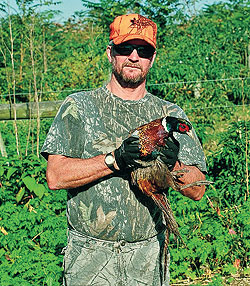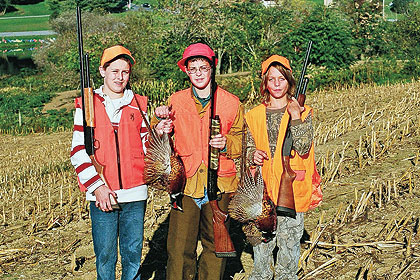Enjoy the present, but look to the future.
By John McGonigle
 A volunteer sportsman prepares to plant a pheasant for the Youth Pheasant Hunt in Lancaster, Pennsylvania. |
Bird hunting will soon be over for the year and serious gun dog owners will be evaluating their bird season, their dogs and their own abilities and accomplishments afield.
Hopefully most of us will have many positives to consider about our well trained, four-legged best friend, including how well the fitness program helped both pup and his owner, and how well the yard training program tightened control when necessary during field conditions.
Friends will brag on their dogs over brews at the local sportsmen's club or bar, and a given amount of BS is accepted because you are friends. Since it is so long until next season one can sometimes get away with a deeper layer than usual, but don't overdo it because some of those friends will likely hunt over your dog again.
Myriad topics related to dogs, birds and shotgun will be talked over and, truth be told, I have a few thoughts I would like to share, so here goes.
I do not want to ring the bell of doom and gloom, but hunters, including small game and migratory bird hunters, are facing a serious problem with declining participation. The 2006 U.S. Fish and Wildlife Service National Survey puts the number of hunters age 16 and over at only 12.5 million, which is just five percent of the total population.
Hunter participation dropped 11 percent since the 1991 national survey. Small game (including rabbits and squirrel) hunters 16 and over numbered only 4.8 million; and migratory bird hunters 16 and over numbered just 2.3 million. The 2006 survey reported that while numbers of big game hunters have remained relatively steady, numbers of small game and migratory bird hunters have declined.
The reasons for declining hunter numbers are numerous: aging hunter population, urban development, lack of habitat, lack of game, increasing costs, increased recreation choices for youngsters, increasing costs of hunting, decline in two-parent homes and an increasingly negative public attitude towards hunting and hunters. Studies show that most hunters leave the field at about age 60, and that hunter recruitment is not making up for their discontinued participation.
State wildlife agencies and sportsmen/conservation groups are attempting to recruit new and young hunters, offering both women's and youth programs. Becoming an Outdoor Woman (BOW) has been successful in many states. Pennsylvania, my home state, is having some success increasing youth hunter participation via its Mentored Youth Hunting program and special Youth Only Hunting days.
Twenty-seven sportsmen's groups in Pennsylvania offered special youth pheasant hunts last fall, and the program is growing.
These programs are having some success but are not without problems. First, there are often not enough follow-up opportunities for women or youngsters to take the next step from complete novices to intermediate shooters and hunters. Secondly, there are often just not enough experienced mentors to work with youngsters.
As a journalist I have attended special Youth Pheasant Hunts and, while they offer positive experiences, it was obvious that many of the parents attempting to assist had little experience and knowledge of safe and proper gun handling techniques and/or of safe pheasant hunting. It must be noted, though, that the sponsoring sportsmen's groups had safe, experienced leadership running the program and assisting with it. Many of the volunteer sportsmen's clubs had individuals with trained gun dogs that hunted with the youngsters.
Fact is, Pennsylvania's pheasant hunting dropped like a rock by the early-to-mid '80s, so many of today's parents were unable to get much firsthand pheasant hunting experience. While the lack of experience is not their fault, it still leaves a vacuum for teaching prospective young hunters to hunt birds, especially with dogs.
 Youngsters must be introduced to bird hunting and be successful on their first outings to encourage them to help carry on our hunting heritage. |
Becoming even more specific, hunters are not buying, training and maintaining gun dogs as in the past. "I'm not paying for a dog since there are hardly any birds to hunt" is a statement I have heard repeatedly for nearly two decades. If Dad does not have a gun dog, youngsters are unlikely to get experience hunting or working with dogs. Dads with gun dogs must get their youngsters involved to carry on our gun dog and bird hunting heritage.
Getting youngsters involved is another good opportunity to recruit club members and participants for dog training groups. The benefits have been discussed here often so we will not go deeply into that. Fact is, though, dog training clubs could and should be giving something back to the sporting community by bringing youngsters into the dog training and bird hunting venue.
Not encouraging wives, significant others and daughters to get into bird hunting and gun dog training is a serious loss to hunting and to ourselves. Women often work very well with gun dogs, especially ones that sometimes butt heads with the "man of the house."
I've seen it happen, and had it happen to me.
Supporting sportsmen's conservation groups like the Ruffed Grouse Society, Pheasants Forever, Quail Forever, Ducks Unlimited and the Delta Waterfowl Association becomes more important as time passes. In southeastern Pennsylvania where I live it is not easy to get land to train dogs on, much less find land to hunt on.
The Nature Conservancy has learned that the only way to protect open land is by purchasing it. Hunters should follow their lead by purchasing land to permanently ensure hunting. The practice is working for the Pennsylvania Game Commission; the agency owns over 1.4 million acres of game lands. Hunters must do more, and bird hunters must get wildlife agencies to designate land for their activities.
That is it, except Barbara Haupt of Maine told me an excellent training trick that she and her husband Cary utilize with their five English cockers to speed up the dog's pick-up on retrieves.
"We often use tennis balls for retrieving training," said Haupt. "The rolling ball encourages the young dogs to continue racing a
fter it, and they tend to grab the ball on the run. Picking up the ball on the run has been carrying over to birds and we are happy with the quicker pick-up and retrieve."
Have a great New Year!






